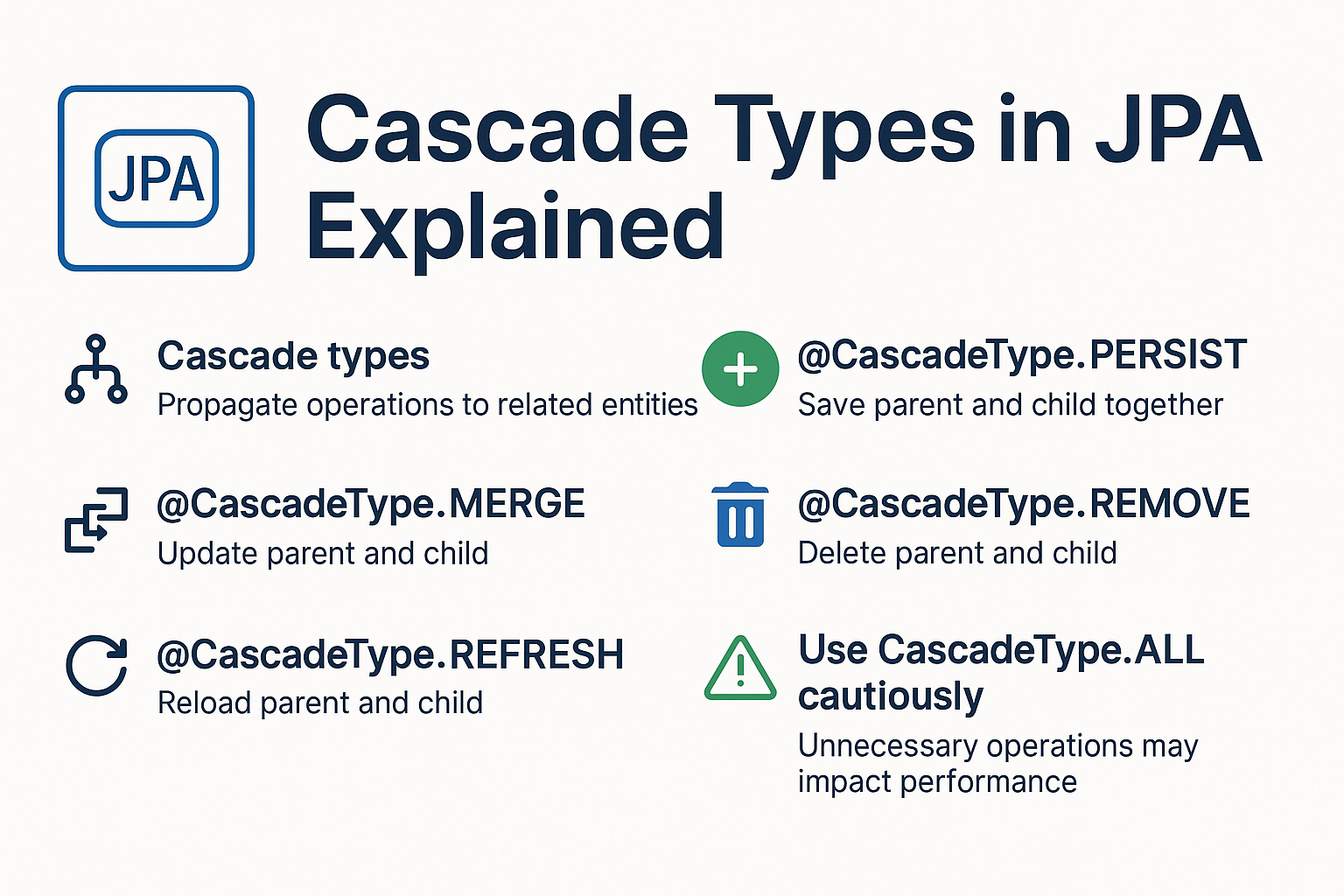In relational data modeling with JPA, entities are often linked through relationships such as One-to-One, One-to-Many, Many-to-One, or Many-to-Many. When you perform an operation (like persist or delete) on a parent entity, should it also apply to its related entities? This is where cascade types come into play.
Cascade operations in JPA define how operations performed on one entity should be propagated automatically to its related entities, making entity management much easier and reducing boilerplate code.
In this tutorial, we’ll explore all JPA cascade types (ALL, PERSIST, MERGE, REMOVE, REFRESH, and DETACH) with real-world examples, best practices, and pitfalls to avoid.
What Are Cascade Types?
Cascade types allow operations performed on a parent entity to cascade down to its child entities. Without cascading, you would have to manually manage the lifecycle of each related entity.
Analogy: Think of a family trip booking. If you cancel the parent’s booking, all child bookings should be canceled too. Cascade ensures that such dependent operations happen automatically.
Setup and Configuration
persistence.xml
<persistence xmlns="https://jakarta.ee/xml/ns/persistence" version="3.0">
<persistence-unit name="my-pu" transaction-type="RESOURCE_LOCAL">
<class>com.example.Department</class>
<class>com.example.Employee</class>
<properties>
<property name="jakarta.persistence.jdbc.driver" value="org.h2.Driver"/>
<property name="jakarta.persistence.jdbc.url" value="jdbc:h2:mem:testdb"/>
<property name="jakarta.persistence.jdbc.user" value="sa"/>
<property name="jakarta.persistence.jdbc.password" value=""/>
<property name="hibernate.hbm2ddl.auto" value="update"/>
<property name="hibernate.show_sql" value="true"/>
</properties>
</persistence-unit>
</persistence>
Entity Example
import jakarta.persistence.*;
import java.util.List;
@Entity
@Table(name = "departments")
public class Department {
@Id
@GeneratedValue(strategy = GenerationType.IDENTITY)
private Long id;
private String name;
@OneToMany(mappedBy = "department", cascade = CascadeType.ALL, orphanRemoval = true)
private List<Employee> employees;
// Getters and setters
}
@Entity
@Table(name = "employees")
public class Employee {
@Id
@GeneratedValue(strategy = GenerationType.IDENTITY)
private Long id;
private String name;
@ManyToOne
@JoinColumn(name = "department_id")
private Department department;
// Getters and setters
}
Cascade Types Explained
1. CascadeType.PERSIST
When saving the parent, the child entities are saved automatically.
Department dept = new Department();
dept.setName("IT");
Employee e1 = new Employee();
e1.setName("Alice");
e1.setDepartment(dept);
dept.setEmployees(List.of(e1));
em.persist(dept); // No need to persist employee separately
Generated SQL:
insert into departments (name) values ('IT');
insert into employees (name, department_id) values ('Alice', 1);
2. CascadeType.MERGE
When merging (updating) the parent, child entities are updated too.
dept.getEmployees().get(0).setName("Alice Updated");
em.merge(dept);
3. CascadeType.REMOVE
When deleting the parent, child entities are deleted too.
em.remove(dept);
SQL:
delete from employees where department_id=?;
delete from departments where id=?;
4. CascadeType.REFRESH
Reloads the entity from the database, discarding unsaved changes.
em.refresh(dept); // Child entities also refreshed
5. CascadeType.DETACH
Detaches both parent and child from the persistence context.
em.detach(dept); // Employees are also detached
6. CascadeType.ALL
Applies all of the above cascade operations (PERSIST, MERGE, REMOVE, REFRESH, DETACH).
@OneToMany(mappedBy = "department", cascade = CascadeType.ALL)
private List<Employee> employees;
CRUD Operations with Cascades
Create
tx.begin();
Department dept = new Department();
dept.setName("HR");
Employee e1 = new Employee();
e1.setName("John");
e1.setDepartment(dept);
dept.setEmployees(List.of(e1));
em.persist(dept);
tx.commit();
Update
tx.begin();
dept.getEmployees().get(0).setName("John Updated");
em.merge(dept);
tx.commit();
Delete
tx.begin();
em.remove(dept);
tx.commit();
Performance Considerations
- Cascades reduce boilerplate but may lead to unintended deletions/updates.
- Avoid using
CascadeType.ALLblindly; be specific. - REMOVE with large collections may cause performance overhead.
- Always monitor SQL generated.
Real-World Use Cases
- CascadeType.PERSIST: Useful when inserting parent-child entities together.
- CascadeType.MERGE: When synchronizing detached entities.
- CascadeType.REMOVE: In tightly coupled parent-child models (e.g., Order ↔ OrderItems).
- CascadeType.ALL: When child lifecycle is fully dependent on the parent.
Anti-Patterns and Pitfalls
- Overusing ALL → accidental deletions.
- Large collections with REMOVE → massive SQL deletes.
- Unidirectional One-to-Many with Cascade → inefficient join tables.
Best Practices
- Be explicit: use only the cascade types you need.
- Use
orphanRemoval=trueto handle dangling child records. - Test with large datasets for performance.
- Prefer bidirectional mappings for clarity.
📌 JPA Version Notes
- JPA 2.0: Introduced Criteria API, Metamodel.
- JPA 2.1: Added Entity graphs, stored procedures.
- Jakarta Persistence: Package renamed from
javax.persistence→jakarta.persistence.
Conclusion and Key Takeaways
- Cascades simplify entity management by propagating operations.
- Types:
PERSIST, MERGE, REMOVE, REFRESH, DETACH, ALL. - Use cautiously to avoid unintended consequences.
- Always test queries generated by cascades in production environments.
By mastering cascade types, you’ll write cleaner, safer, and production-ready JPA code.
FAQ
1. What’s the difference between JPA and Hibernate?
JPA is a specification, Hibernate is an implementation.
2. How does JPA handle the persistence context?
It manages entities in memory until flush or commit.
3. What are the drawbacks of eager fetching in JPA?
Unnecessary joins and memory usage.
4. How can I solve the N+1 select problem with JPA?
Use JOIN FETCH or batch fetching.
5. Can I use JPA without Hibernate?
Yes, with EclipseLink or OpenJPA.
6. What’s the best strategy for inheritance mapping in JPA?JOINED for normalization, SINGLE_TABLE for speed.
7. How does JPA handle composite keys?
With @EmbeddedId or @IdClass.
8. What changes with Jakarta Persistence?
Namespace moved from javax.persistence to jakarta.persistence.
9. Is JPA suitable for microservices?
Yes, but DTOs are recommended.
10. When should I avoid using JPA?
In high-performance batch or NoSQL scenarios.
